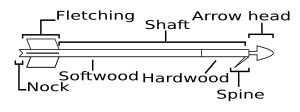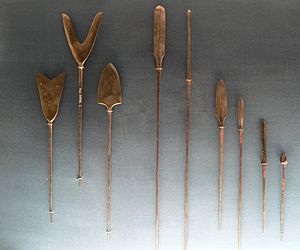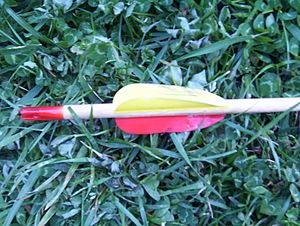Arrow facts for kids
An arrow is a long, thin stick-like object shot from a bow. It's a type of projectile used as a weapon for hunting and defense. People have used bows and arrows for thousands of years, even before medieval times. Many cultures around the world have relied on them.
Arrows have a sharp point at one end. The other end usually has "flights" or "fletchings," which are often made of feathers. These fletchings help the arrow fly straight through the air towards its target.
Contents
History of Arrows
The earliest signs of stone-tipped tools that might have been arrows or spears date back about 64,000 years. These were found in Sibudu Cave in South Africa.
The oldest proof of bows being used to shoot arrows is from about 10,000 years ago. This evidence comes from pinewood arrows found in Germany. These arrows had small grooves, showing they were shot from a bow. The oldest actual bow found is about 8,000 years old, discovered in Denmark.
Bows and arrows likely arrived in the Americas around 4,500 years ago.
Arrow Size and Parts
Arrows come in many different sizes, from about 18 inches (45 cm) to 5 feet (150 cm) long. Most modern arrows are between 30 inches (75 cm) and 38 inches (96 cm) long. For example, war arrows from an English ship that sank in 1545 were about 30 inches (76 cm) long.
Some very short arrows were also used. These were shot using a special guide attached to the bow or the archer's wrist. These short arrows could fly very far.
The Arrow Shaft
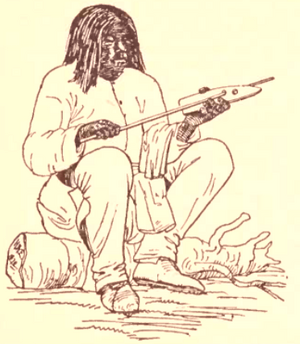
The shaft is the main body of the arrow. All the other parts are attached to it. In the past, arrow shafts were made from strong, light materials like wood, bamboo, or reeds. Today, shafts can be made from aluminium, carbon fibre reinforced plastic, or a mix of materials. Some modern shafts have an aluminum core wrapped in carbon fiber. A popular traditional wood for shafts is Port Orford Cedar.
The stiffness of the shaft is called its "spine." A shaft with more spine bends less when pushed. For arrows to fly accurately, a set of arrows should have similar spine stiffness.
Bows where the arrow passes through the center of the bow handle can use arrows with different spine stiffness. However, most traditional bows are not "center-shot." The arrow has to bend slightly around the handle when shot. These bows work best with arrows that have a specific spine stiffness. Stronger bows (with higher "draw-weight") usually need stiffer arrows that bend less.
Arrow Weight (GPI)
The weight of an arrow shaft is sometimes measured in GPI, which stands for "Grains Per Inch." To find the shaft's total weight in grains, you multiply its length in inches by its GPI rating. For example, a 30-inch shaft with a GPI of 9.5 weighs 285 grains (about 18 grams). This weight is just for the shaft; a complete arrow with an arrowhead and fletchings will be heavier.
Footed Arrows
Sometimes, an arrow shaft is made from two different types of wood joined together. This is called a "footed arrow." Many early Europeans and Native Americans used these arrows. Footed arrows usually have a short piece of hardwood near the arrowhead. The rest of the shaft is made of softwood. This design makes the arrow stronger where it's most likely to break, while keeping it flexible and light overall.
Arrowheads
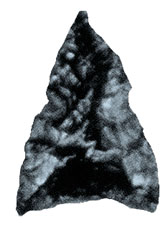

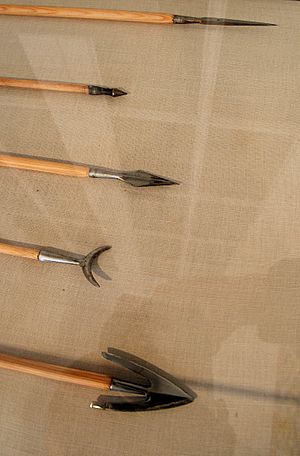
The arrowhead is the most important part of the arrow for its purpose. Some arrows just have a sharpened tip of the shaft itself. But usually, separate arrowheads are made from metal, horn, or other hard materials. Arrowheads are designed for different uses:
- Bodkin points are short, stiff points with a small cross-section. They were often made of iron. People once thought they were mainly for piercing armour, but they were likely also used for longer flight or cheaper production. In tests, a strong bodkin point could pierce chain armour. However, arrows were not very effective against plate armour, which became common in the late 1300s.
- Blunts are unsharpened arrowheads. They are used for target practice, shooting at stumps, or hunting small animals. The goal is to stun the target without piercing it. Blunts are usually made of metal or hard rubber. Even with blunt arrows, safety is very important.
- Judo points have spring wires sticking out from the tip. These wires catch on grass and debris, stopping the arrow from getting lost in plants. They are used for practice and hunting small game.
- Broadheads were used in wars and are still used for hunting. Medieval broadheads were often made of steel. They usually have two to four sharp blades that cause a lot of bleeding in the target. Their job is to make a wide cut to kill quickly by damaging major blood vessels. They are expensive and usually not used for practice.
Hunters use two main types of broadheads:
-
- Fixed-blade broadheads have blades that stay rigid and don't move.
- Mechanical broadheads have blades that open up when they hit the target. Mechanical heads fly better because they are more streamlined. However, they might not go as deep because some of the arrow's energy is used to open the blades.
- Field tips are like target points but have a distinct shoulder. This design helps prevent them from getting stuck in things like tree stumps if you miss your shot outdoors. Hunters also use them for practice because they fly similarly to broadheads but don't damage targets as much.
- Target points are bullet-shaped with a cone tip. They are designed to easily go into target butts without causing too much damage to them.
- Safety arrows are made for pretend combat, like in historical reenactments. They are designed to be safer when shot at people. These arrows might have very wide or padded heads. When used with bows that have limited power, these heads can reduce the risk of injury when shooting at people wearing proper armour. For example, in the SCA, safety arrows need a padded head at least 1.25 inches (3.17 cm) wide. The bows used must not be too strong.
Arrowheads can be attached to the shaft in different ways:
- With a cap that slides over the end of the shaft, sometimes held with hot glue.
- By inserting a tang (a pointed part of the arrowhead) into a split in the shaft. This is then secured with a ferrule, animal sinew, or wire. This process is called hafting.
Fletchings

Fletchings are found at the back of the arrow. They act like small wings that help stabilize the arrow's flight. They keep the arrow pointing straight by stopping it from wiggling up and down or side to side. Some cultures, like many in New Guinea, didn't use fletchings on their arrows. Arrows without fletchings (called "bare shafts") are also used for training. They make it easier to see mistakes the archer might be making.
Fletchings are traditionally made from feathers, often from a goose or turkey. These feathers are tied or glued to the arrow's shaft. Today, fletchings are often made of plastic and are called "vanes."
Most arrows have three fletchings. One feather, called the "cock" feather, is placed at a right angle to the nock (the notch where the arrow connects to the bowstring). This way, it won't hit the bow when the arrow is shot. Arrows with four fletchings are usually symmetrical, so it doesn't matter how you put the nock on the string. This makes it a bit easier to load the arrow.
Natural feathers are usually prepared by splitting and sanding the quill before gluing. They are then shaped by trimming or burning with a hot wire. It's important that all feathers on an arrow have the same amount of drag for consistent flight.
Some fletchings are dyed. Often, the front fletching is camouflaged, and the back fletching is bright. This helps the archer easily see and track the arrow in flight.
People who make arrows by hand are called "fletchers." This word comes from the French word for arrow, flèche. The verb "fletch" means to add feathers to an arrow. Traditionally, fletchings were attached with glue and thread. Today, a "fletching jig" is often used. This tool holds the fletchings in the perfect position on the shaft while the glue dries.
When using natural feathers, all feathers on one arrow must come from the same wing of the bird. For example, right-wing feathers from turkeys are common. The slight curve of natural feathers makes them spin the arrow as it flies. This spinning helps the arrow fly straight. Artificial "helical" fletchings (which are twisted) have the same effect.
Most arrows have three fletchings, but some have four or more. Fletchings are usually between two and six inches (5 to 15 cm) long. Arrows meant to fly very far often have small fletchings to reduce air resistance. Hunting arrows with broadheads need longer and taller fletchings to keep them stable because of the broadhead's shape. Fletchings can also be cut into different shapes, like "parabolic" (a smooth curve) or "shield" (shaped like half a narrow shield).
In modern archery with screw-in points, a right-hand spin is often preferred because it helps the points stay tight. In traditional archery, some archers prefer a left spin. This moves the hard, sharp quill of the feather away from the arrow rest and the shooter's hand.
A Flu-Flu Arrow is a special type of fletching. It usually uses long sections of full-length turkey feathers, often six or more, instead of the usual three. Another way to make them is by spiraling two long feathers around the end of the arrow shaft. The extra fletching creates a lot of drag, which slows the arrow down quickly after a short distance (about 30 meters or so).
Flu-Flu arrows are often used for hunting birds or for children's archery. They can also be used to play Flu-Flu Golf.
Images for kids
-
Warring States bronze arrowheads
See also
 In Spanish: Flecha para niños
In Spanish: Flecha para niños



